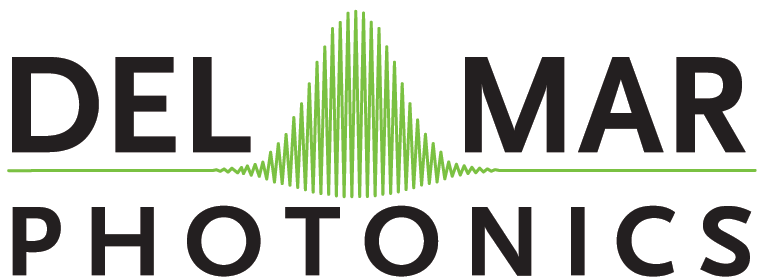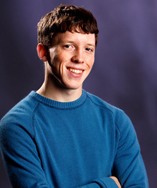
Del Mar Photonics - Del Mar Photonics Fall 2010 Newsletter
Best poster award at IONS-NA-2 in Tucson, Arizona is sponsored by Del Mar Photonics

The winner was James Feeks from the University of St. Thomas

Measurement and Reduction of Instrumental Asymmetries in an
Electron Circular Dichroism Apparatus (pdf)
J. Feeks a), E. Litaker b), T.J. Gay b)
a) University of St. Thomas, Department of Physics
b) University of Nebraska-Lincoln, Department of Physics and Astronomy
A type of molecule which has great significance in biology and organic chemistry
is one that has no reflection plane of symmetry. This type of molecule is called
a ‘handed’, or chiral molecule. Opposite-handed chiral molecules differ in how
they scatter polarized light. For example, they can exhibit “circular
dichroism”, meaning that the index of refraction of a solution of these
molecules will be unequal for light waves with opposite circular polarization.
As a result, light with right-hand circular polarization will be absorbed
differently than light with left-handed circular polarization. In 1980, Farago
laid the foundation for a new phenomenon analogous to optical circular
dichroism, this time concerning electrons of opposite longitudinal spin [1]. He
called it “electron circular dichroism” (ECD), which describes how a beam of
longitudinally polarized electrons will be attenuated based on the parallel or
antiparallel relationship between their spins and momenta, and the target
chirality. The first experimental work on ECD was done by Campbell and Farago in
1985, when they observed an asymmetry in the transmission of
longitudinally-polarized electrons of opposite spin through a camphor vapor [2].
The significance of this research is mainly in its contribution to the
understanding of molecular structure and basic collision physics, but it can
also give us clues about the curious phenomenon of homochirality in
biochemistry: the fact that all essential biopolymers exist with only one type
of chirality. This applies to proteins, DNA, and RNA.
Since Farago’s initial findings, both Kessler’s group and Gay’s group have
performed similar experiments with camphor [3,4]. In recent years, Fabrikant et
al. have attempted to minimize the helicity-dependent intensity asymmetry of
light used to produce the polarized electrons in these experiments, in order to
reduce instrumental asymmetries below the threshold of the theoretical limit for
observing ECD [5]. This asymmetry reduction technique focused mostly on
intensity variations. However, both spatial and intensity variations related to
helicity are of concern in the optical setup (Fig. 1). Spatial variations can
arise because the light is split into orthogonal linear polarization states by a
beam splitter, which each pass through a single chopper oriented such that only
one polarization state is transmitted at a time, and are then recombined
spatially at a second beam splitter. Any spatial variations can cause an
instrumental asymmetry if the photoemission efficiency of the gallium arsenide
crystal (which emits the polarized electrons) varies across its surface. Even if
the beam were perfectly recombined such that
no spatial variation occurred, a helicity dependent laser intensity variation
could also mimic the asymmetry expected as a result of ECD. As such, both need
to be minimized.
To quantify the spatial variation of the laser beam we used a position sensitive
photodiode interfaced with a computer. Beginning with only the laser, the
variations were measured as each optical component was added to the set up, in
order to determine which component(s) cause appreciable variation. In
particular, it was important to quantify laser stability as laboratory
conditions varied. This report will discuss the results of the data taken, as
well as potential improvements to the setup that will minimize the instrumental
asymmetry as a result of the optics in the apparatus.
Fig. 1 – Optical Setup. The laser passes through a liquid crystal variable
retarder (1) which adjusts for intensity asymmetry, then is split into
orthogonal linear polarization states by a beam splitter (2). Only one state is
allowed to pass through the chopper (3) at any given time. The beam is then
recombined spatially by another beam splitter (4), but the oppositely polarized
beams are not recombined temporally. The quarterwave plate (5) converts the beam
to orthogonal circular polarization states, which then reach the crystal or a
detector (6).
[1] P.S. Farago, J. Phys. B 13, L567 (1980).
[2] D.M. Campbell and P.S. Farago, Nature 318, 52 (1985)
[3] S. Mayer and J. Kessler, Phys. Rev. Lett. 74, 4803 (1995)
[4] K.W. Trantham et al., J. Phys. B 28, L543 (1995)
[5] M.I. Fabrikant et al., Appl. Opt. 47:13, 2465 (2008)

Del Mar Photonics, Inc.
4119 Twilight Ridge
San Diego, CA 92130
tel: (858) 876-3133
fax: (858) 630-2376
Skype: delmarphotonics
sales@dmphotonics.com
www.twitter.com/TiSapphire